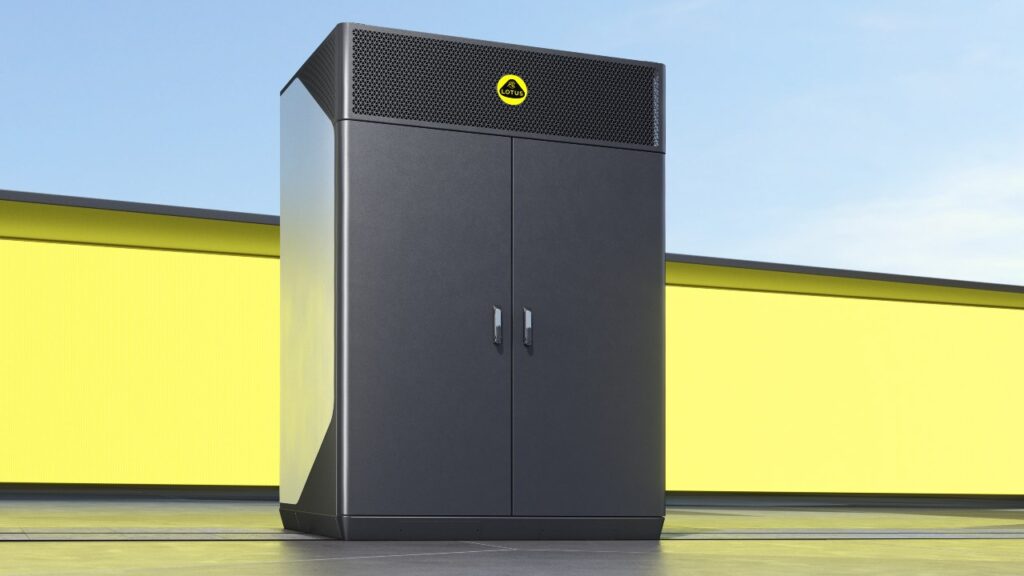The British luxury car marque launches new-age EV charging solutions, built in-house, which have capabilities of upto 450 kW DC charging.
The latest press release confirms that Lotus has come up with its own EV charging solutions with some enticing features. The range of solutions includes an ultra-fast 450 kW DC charger, a power cabinet and a modular unit which enables 4 vehicles to get charged simultaneously. Lotus employs liquid-cooled technologies across its range of commercial charging solutions, enhancing the convenience and speed of electric vehicle charging for drivers.
You might also like: How EVs Perform 360-Degree Turns On The Spot?

You might also like: Could Dongfeng M-Hero 917 Be Perfect Rival to Hummer EV?
Lotus Launches EV Charging Solutions
Concerns about charging continue to be a major obstacle to the widespread adoption of electric vehicles, as revealed in a survey by the Energy Policy Institute. As per this study, almost 80% of respondents identified the lack of charging infrastructure as a key reason for not choosing an EV.
Lotus addresses this issue by offering charging capabilities that instil reliability and confidence in consumers. These fast-charging solutions are already operational in the Chinese market. By Q2 2024, they are slated to be rolled out across the majority of European nations and the Middle East. The EV charging suite includes:
Liquid-Cooled All-in-One DC Charger
Introducing a cutting-edge charger that delivers ultra-fast charging capabilities of up to 450 kW. Take, for instance, the Lotus Eletre R, which can swiftly add an impressive 88.5 miles or 142 km of range in just 5 minutes, establishing it as one of the most competitive electric vehicle chargers in the market. Achieving a charge level from 10% to 80% takes a mere 20 minutes. This translates to increasing range by 74 miles or 120 km with just a 5-minute charge when utilizing a 350 kW Rapid Charger.
Liquid-Cooled Power Cabinet
An adaptable power cabinet designed for spaces demanding high energy for enhanced efficiency and reduced charging times. It is particularly ideal for locations like motorway rest stops. This unit boasts market-leading power output capabilities, reaching up to 480 kW.
Liquid-Cooled Charging Unit
A charging terminal, when paired with the Liquid-Cooled Power Cabinet, has the capacity to charge up to four vehicles simultaneously. With a maximum current output of 600 Amp, the unit is well-equipped to cater to the requirements of all electric vehicle drivers. Whether they require a quick top-up during a journey or a rapid charge for long-distance travel, Lotus’ new solution offers a convenient option.
You might also like: Top 5 Unique Upcoming Electric Pickup Trucks in 2024
Lotus EV Range
In 2022, the company introduced its inaugural electric hyper-SUV, Eletre, with customer deliveries taking place in the UK, Europe, and China throughout the current year. Lotus recently unveiled Emeya, its next-generation electric hyper-GT, in early September 2023.
Both vehicles incorporate a comprehensive suite of intelligent driving technologies, integrating hardware, software, and cloud capabilities. They are equipped with HD cameras, radar systems, and high-precision mapping features, enabling precise environmental perception through a stereoscopic display. This technology ensures a smooth driving experience, even in challenging conditions. Lotus is committed to expanding its lineup of premium electric vehicles to capitalize on the growing market demand.
The demand for Lotus products has been substantial, with an order book exceeding 19,000 vehicles for its Emira sports car and Eletre hyper-SUV. The company has significantly increased production this year, achieving record-breaking results in the first half of 2023. Furthermore, it anticipates surpassing all previous annual performance by the end of the year.

You might also like: Best Methods and Challenges of Recycling Electric Vehicle Batteries
Learn Electric Cars Says
As global electric vehicle manufacturing and adoption continue to expand, the emergence of new technologies in areas such as battery development, battery management, and charging infrastructure is inevitable. Given the early stage of development in this domain, automakers are actively exploring the establishment of proprietary charging solutions. Lotus’ recent initiative exemplifies this trend. By internally developing a majority of the crucial components in their electric vehicles, Lotus aims to optimize packaging and extract peak performance and range from their products. This strategic approach reflects the industry’s commitment to advancing and refining electric vehicle technologies.


Pingback: เช่ารถตู้พร้อมคนขับ
Pingback: โบท็อกราคา
Pingback: สติกเกอร์สินค้า
Pingback: ทำความรู้จักค่ายเกม Microgaming
Pingback: ทางเข้า lucabet
Pingback: ทัวร์ธุรกิจจีน
Pingback: Tor Links
Pingback: ยางยอย
Pingback: y2k168
Pingback: plinko
Pingback: ufa777
Pingback: Sweettooth
Pingback: M358 รับโบนัสเยอะ
Pingback: สั่งสินค้าจากจีน
Pingback: Labubu display case